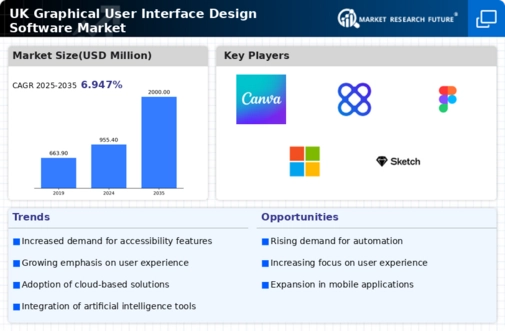Rise of Mobile-First Design Strategies
The shift towards mobile-first design strategies is significantly impacting the graphical user-interface-design-software market. With the increasing use of mobile devices for accessing digital content, designers are prioritising mobile compatibility in their projects. This trend is reflected in the market, where mobile design tools are projected to capture around 40% of the total software market share by 2027. As businesses in the UK adapt to this mobile-centric landscape, the demand for software that supports responsive design and mobile optimisation is likely to rise. Consequently, the graphical user-interface-design-software market is expected to evolve, with a greater emphasis on tools that facilitate seamless transitions between various screen sizes and devices.
Emphasis on Cross-Platform Compatibility
The emphasis on cross-platform compatibility is becoming increasingly vital in the graphical user-interface-design-software market. As users access applications across various devices and operating systems, the need for software that supports seamless cross-platform design is paramount. In the UK, the market for cross-platform design tools is projected to grow by approximately 20% in the coming years, as businesses seek to ensure a consistent user experience across all platforms. This trend is driving the development of tools that facilitate the creation of interfaces adaptable to different environments. Consequently, the graphical user-interface-design-software market is likely to expand, with a focus on solutions that enable designers to efficiently manage cross-platform challenges.
Growing Importance of Data-Driven Design
Data-driven design is emerging as a crucial driver in the graphical user-interface-design-software market. As organisations increasingly rely on analytics to inform their design choices, the demand for software that integrates data analysis tools is on the rise. In the UK, it is estimated that around 30% of design teams are now utilising data to guide their design processes. This trend not only enhances the effectiveness of user interfaces but also allows for more targeted design strategies. As a result, the graphical user-interface-design-software market is likely to witness a surge in tools that offer robust data integration capabilities, enabling designers to make informed decisions based on user behaviour and preferences.
Increasing Demand for User-Centric Design
The graphical user-interface-design-software market is experiencing a notable shift towards user-centric design principles. As businesses in the UK increasingly recognise the importance of enhancing user experience, there is a growing demand for software that facilitates intuitive and engaging interfaces. This trend is reflected in the market, where user-centric design tools are projected to account for approximately 35% of total software sales by 2026. Companies are investing in these tools to ensure their products meet the evolving expectations of users, thereby driving growth in the graphical user-interface-design-software market. Furthermore, the emphasis on user feedback and iterative design processes is likely to further fuel this demand, as organisations strive to create more personalised and effective user experiences.
Integration of Advanced Prototyping Features
The integration of advanced prototyping features within graphical user-interface-design-software is becoming increasingly prevalent. This development allows designers to create interactive prototypes that closely mimic the final product, thereby enhancing the design process. In the UK, the market for prototyping tools is expected to grow by approximately 25% over the next few years, as businesses seek to streamline their design workflows. These features not only improve collaboration among teams but also facilitate quicker iterations based on user testing. As a result, the graphical user-interface-design-software market is likely to see a surge in demand for tools that offer robust prototyping capabilities, enabling designers to validate concepts and refine user interfaces more effectively.
















Leave a Comment